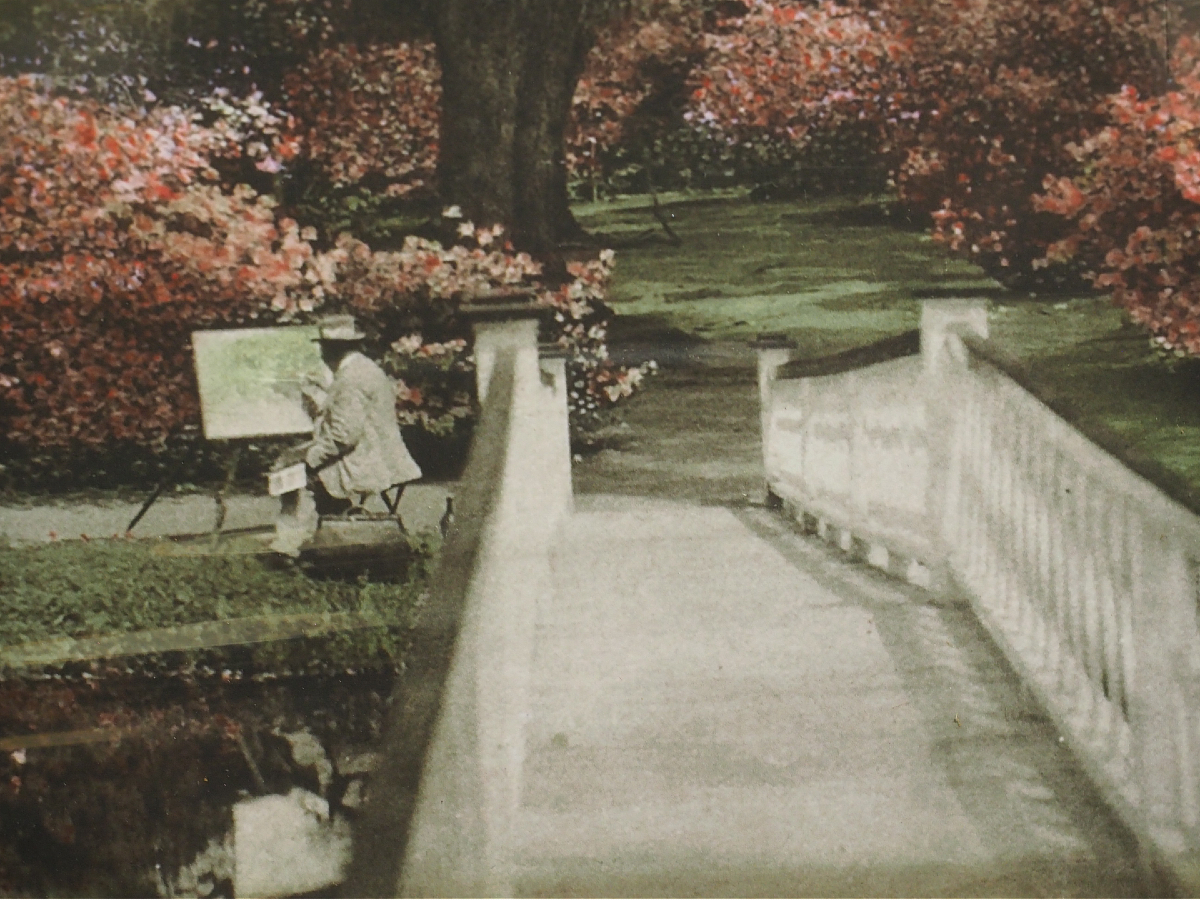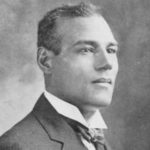
Historians and art enthusiasts believe that when Charleston artist Edwin Augustus Harleston was denied entry to Magnolia Plantation and Gardens, he painted an image of himself in this 1920s panoramic view of the White Bridge at Magnolia, as shown in this close-up view. The bridge, built from cypress in the 1840s, is currently undergoing extensive repair after a mass tree fell on it this summer. A copy of the original Harleston photo is on sale at Magnolia’s gift shop. (Photos by Herb Frazier)
By Herb Frazier, special to Charleston Currents | A hand-tinted photograph captures a unique panoramic view 90 years ago of the iconic White Bridge at Magnolia Plantation and Gardens with a glimpse of the pointed cupola of Magnolia’s Main House.
What gives this old-fashioned picture an even more intriguing tinge, however, is a haunting image of a well-dressed artist painted into the photo as a bygone act of defiance against southern racial norms at that time.
Wearing what appears to be a seersucker suit and straw hat, the artist, seated before an easel, is dwarfed by the foot bridge, towering oaks and bushy azaleas in a late 1920s snapshot of America’s oldest garden.
Today, a copy of that original wide-angled view hangs in the sitting room of Magnolia’s Main House where the artist ̶ presumably Edwin Augustus Harleston ̶ would not have been invited for dinner because of his mixed parentage. His mother was a free person of color, and his father descended from a white planter and a woman he enslaved.
Two women who know Harleston’s story and his paintings lament he could have been a darling of America’s art scene if it had not been for the demands of a family-owned funeral home and Jim Crow laws. Harleston painted during an arts revival from the early- to mid-20th century called the Charleston Renaissance. White artists shunned him even though he was considered the best black portrait and landscape artist of his time.
In a Feb. 2, 1930, letter Harleston asked Magnolia’s owner C. Norwood Hastie Sr. for permission to paint in the gardens. Three days later, Hastie denied the request. Although Hastie didn’t mention Harleston’s race, it was widely understood then the gardens were off limits to black people. Since Harleston was turned away, he likely brushed his likeness into the photo. Ironically, the framed photo hangs above a table with Hastie’s picture on it.
Harleston painted at least three landscapes in Magnolia’s gardens before he wrote to Hastie. Mae Whitlock Gentry, Harleston’s great-niece, said since her uncle studied landscape painting at the Art Institute of Chicago, he wanted to return to Magnolia, a place he considered to be one of the most stunning gardens in the country. Harleston initially gained entry to the gardens disguised as part of a black carpentry crew led by Thomas Mayhem Pinckney. Magnolia hired him to build Magnolia’s footbridges, according to Susan V. Donaldson’s essay “Charleston’s Racial Politics of Historic Preservation: The Case of Edwin A. Harleston.” Pinckney was married to Harleston’s cousin.
As he painted or sketched the gardens, Harleston also may have taken the picture. The photo also might have been taken by Harleston’s wife, Elise Forrest Harleston, an accomplished portrait photographer whose photos inspired her husband’s paintings. Elise Harleston hand-tinted some of her pictures. But Gentry added she’s never seen a wide-view photo in her collection. The Magnolia garden image was likely made with two black-and-white negatives spliced together.
A friend of Magnolia board member Taylor Drayton Nelson gave him the Harleston photo in 2006. Years after Magnolia received the photo, the word “Harleston” was noticed on the back of the image.
“We can only surmise the image of the artist sitting at the easel was Harleston,” said Gentry, who lives in Burbank, Calif. “He was the only artist named Harleston in Charleston, and we know he visited Magnolia Gardens. So we can surmise that it is Edwin Harleston. We don’t know for sure, and I don’t think we’ll ever know.”
If Harleston had come along after racial segregation, he could have achieved artistic greatness nationally, Charleston tour guide Ruth Miller said. Harleston studied in the north where he found less discrimination and respect, she said. Harvard University accepted him, but instead he studied at the Boston Museum of Fine Arts and later the Art Institute in Chicago. His time in Boston was interrupted when his father, Edwin Gaillard Harleston, ordered him home to help with the family-owned Harleston Funeral Home, once located on Calhoun Street.
Miller owns two Harleston paintings of the gardens at Magnolia. Gentry said she’s aware of a third once owned by the writer and first African-American Rhodes Scholar, Alain LeRoy Locke. Letters that Harleston exchanged between Locke and Hastie, Magnolia’s owner, are part of Harleston’s papers that Gentry donated in 2010 to Emory University in Atlanta, where she was a reporter and editor at the Atlanta Journal-Constitution.
As an artist Harleston “would have become nationally recognized if he had been able to settle in Washington, D.C., which is where he wanted to be,” Miller said. She also cites Spelman College art history professor Maurine Akua McDaniel’s reflection of Harleston in her book, Edwin Augustus Harleston: Envisioning the Talented Tenth. McDaniel wrote: “After living a comparatively free life as an artist in Boston, Harleston found it hard to acknowledge the fact that he could never compete with white artists in Charleston … even though he was probably the only academically trained painter in the city. Harleston also did not get national recognition because he died relatively young.”
Harleston’s father died of pneumonia in April 1931. A grief-stricken Harleston kissed his dying father on the lips and then he fell to the same disease weeks later at age of 49.
Herb Frazier is a Charleston-based writer. He’s the former public relations director at Magnolia Plantation and Gardens.





 We Can Do Better, South Carolina!
We Can Do Better, South Carolina!
























